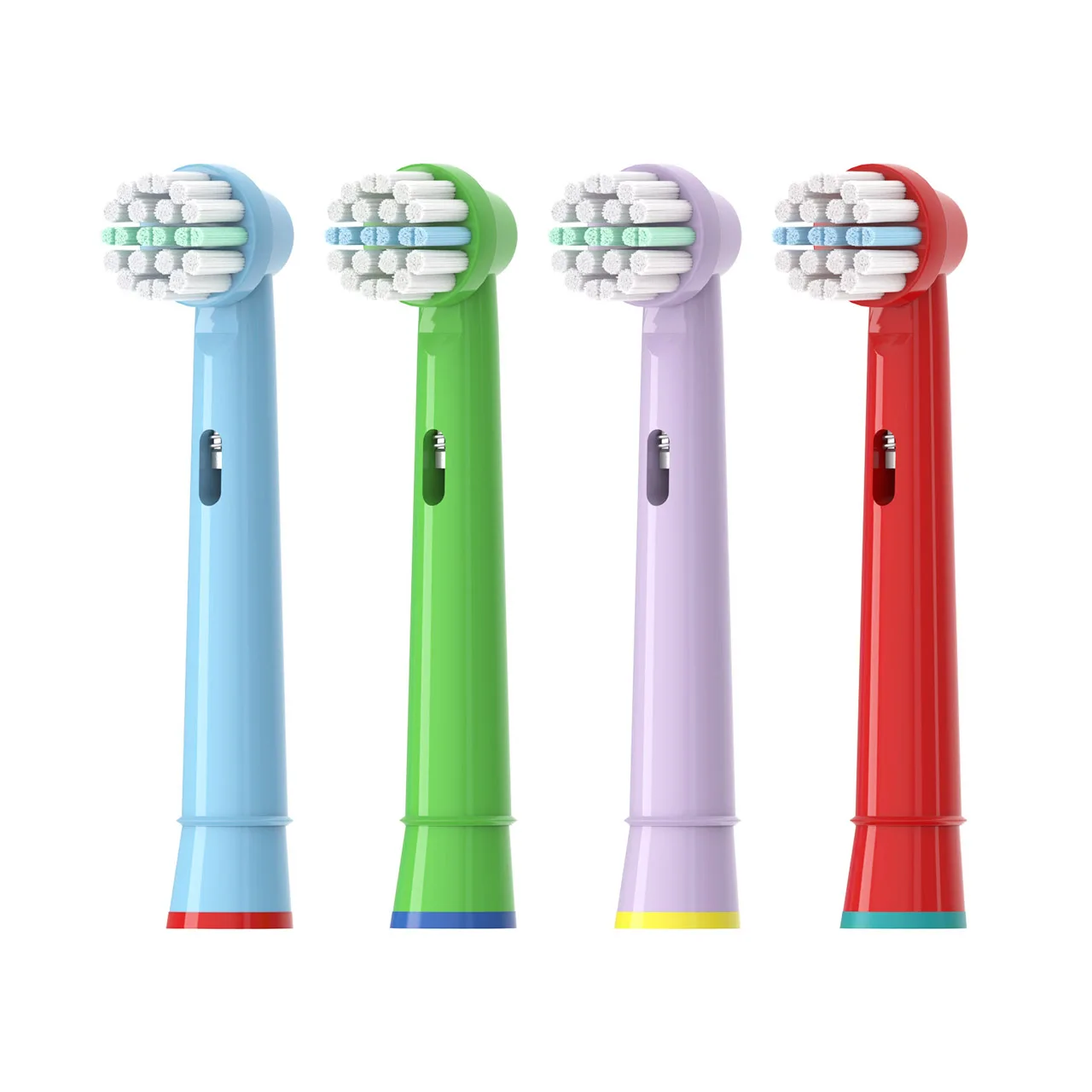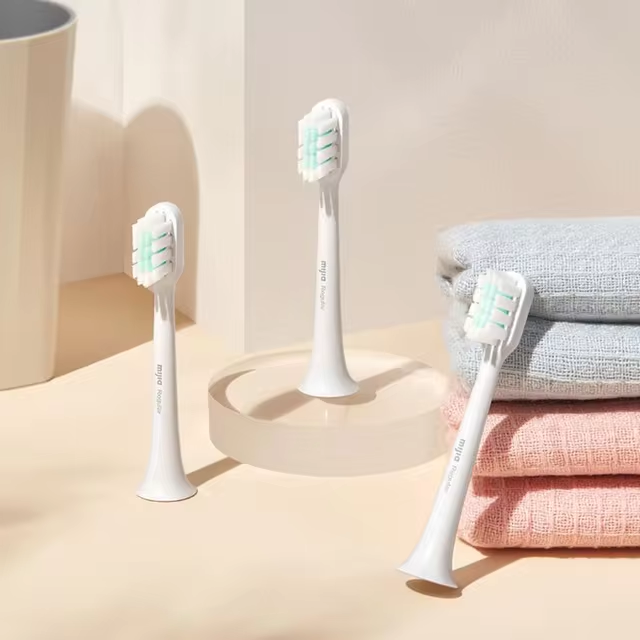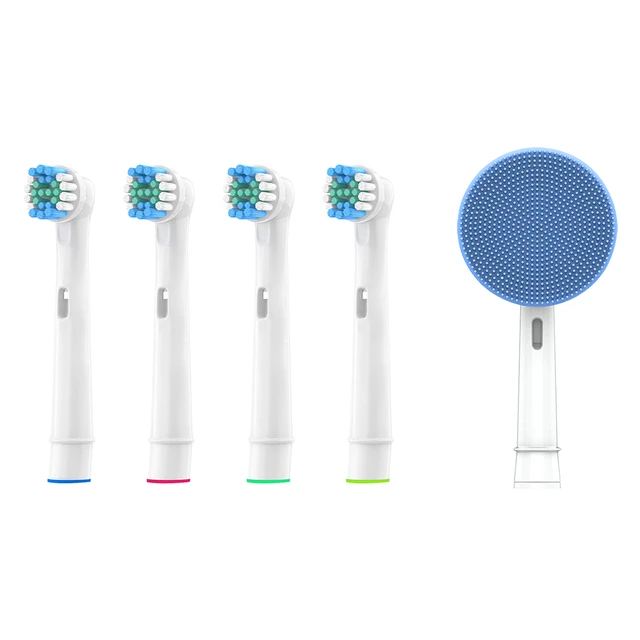Introduction to Toothbrush Head Replacement
In the world of dental care, toothbrush head replacement is a key practice. Experts stress its importance for maintaining oral health. Yet, many overlook this task in their daily routines. Have you checked your toothbrush head lately? If not, it’s time to learn when and why to change it.

Every toothbrush head has a lifespan, after which it stops being effective. Worn bristles can’t clean teeth well, affecting your oral hygiene. Besides, old brush heads may harbor harmful bacteria. To keep your mouth clean and healthy, you must replace toothbrush heads periodically.
How often should this happen? The consensus among dental professionals is to do so every three months. However, if you notice bristles bending or fraying before that, don’t wait. Change the toothbrush head right away to ensure good brushing results.
Remember, a fresh toothbrush head is crucial for a clean mouth and a bright smile. Let’s dive deeper into why regular replacement is essential and how to do it right.
Recognizing the Signs of Wear on Toothbrush Heads
It’s crucial to recognize when your toothbrush head needs replacing. Here are the tell-tale signs of wear:
- Frayed Bristles: Check if the bristles look frayed or mangled. These are less effective at cleaning.
- Bent Bristles: If bristles bend out of shape, they can’t reach between teeth as well.
- Faded Indicators: Many heads come with color-changing bristles to signal it’s time to change.
- Uneven Bristles: Bristles should appear uniform. If not, they won’t clean evenly.
Worn toothbrush heads can’t clean teeth thoroughly, risking your oral health. Spotting these signs early means better hygiene and less chance of dental issues. So, keep an eye on your brush, and replace it when these signs show up.
Optimal Replacement Frequency for Electric Toothbrush Heads
Maintaining oral health includes recognizing when to replace electric toothbrush heads. Consensus among experts suggests every three months. This timeline ensures bristles remain effective for removing plaque and preventing cavities. Look for these indicators:
- Bristles spread out or frayed
- Bristles’ stiffness reduces
- Color indicators fade or disappear
If you brush more rigorously or more than twice daily, consider replacing heads earlier. Bristles wear down faster with overuse. Brushing habits, force applied, and brush head quality affect lifespan. Monitor brush heads regularly. Replace them at first wear signs for optimal dental hygiene. Stay ahead of potential oral health issues by maintaining a healthy toothbrush head replacement schedule.
Importance of Regular Toothbrush Head Replacement
Replacing your toothbrush head regularly is not just about keeping it fresh; it’s vital for your oral health. Here are some reasons why:
- Preventing Bacterial Growth: An old toothbrush head can become a breeding ground for bacteria, which can lead to infections and cavities if introduced back into your mouth.
- Ensuring Effective Cleaning: Over time, bristles lose their rigidity. This makes them less effective at removing plaque and cleaning between teeth.
- Gum Health: Worn bristles can be harsh on gums, potentially causing irritation or contributing to gum disease.
- Overall Dental Health: A fresh toothbrush head helps maintain dental health, reducing the risk of cavities, bad breath, and other oral hygiene problems.
To keep your toothbrush effective, remember to change its head every three months. If you see frayed bristles or notice the color indicators fading, replace it sooner. By doing so, you ensure that your brushing routine is as effective as possible, safeguarding your smile.
Best Practices for Toothbrush Head Maintenance
To ensure your toothbrush head stays clean and functional, follow these best practices:
- Rinse Thoroughly: After brushing, rinse the toothbrush head with water to remove toothpaste and debris.
- Don’t Share Toothbrush Heads: Never share your toothbrush with others to prevent the spread of bacteria.
- Store Properly: Keep your toothbrush in an upright position to allow it to air-dry. Avoid closed containers, which can promote bacteria growth.
- Avoid Heat and Direct Sunlight: Do not leave the toothbrush in hot places or in direct sunlight, as this can damage the bristles.
- Use Protective Covers Wisely: If using a protective cover, make sure it has ventilation holes. This will help keep the brush dry and prevent bacterial growth.
- Keep it Separate: If stored with other brushes, ensure heads don’t touch to avoid cross-contamination.
- Regular Inspections: Check the toothbrush head often for signs of wear, and replace it as needed.
- Follow Manufacturer’s Instructions: Use the toothbrush as recommended by the manufacturer, including brush strokes and timings, to prolong the life of the toothbrush head.
By keeping up with these maintenance tips, you’ll help maintain optimal dental hygiene and extend the lifespan of your toothbrush head.
 Innovative Features to Track Toothbrush Head Lifespan
Innovative Features to Track Toothbrush Head Lifespan
Modern electric toothbrushes come with innovative features. These make it easier to track the lifespan of brush heads.
Color Indicator Bristles
Some toothbrush heads include bristles that change color. As bristles wear, they fade, signaling replacement time.
Bristle Shape Memory
Advanced toothbrush heads have bristles that spring back to their original shape. When they don’t, it’s time to change.
Replacement Reminder Systems
Electric toothbrushes may have built-in reminder systems. They alert you every three months or upon relevancy.
Smart Toothbrushes with Apps
Many smart toothbrushes connect to apps. These apps track brushing patterns and recommend when to switch out heads.
Subscription Services
Subscription services can prompt timely replacements. They deliver new heads before the old ones wear out.
Embedding these features into toothbrush design helps maintain oral health. They prompt timely replacement, ensuring effectiveness and hygiene. Take advantage of them to keep your smile healthy and bright.
How Brushing Habits Affect Toothbrush Head Longevity
Your brushing habits play a pivotal role in how long your toothbrush head lasts. Forceful brushing or using the toothbrush more than twice a day may lead to quicker bristle degradation. Here are key factors that impact the longevity of your toothbrush head:
- Brushing Frequency: Brushing more than the standard twice a day speeds up wear and tear.
- Brushing Technique: Vigorous brushing can cause bristles to splay and break down faster.
- Brushing Time: Longer brushing sessions put additional stress on the brush head.
- Brushing Pressure: Applying excessive pressure can damage the bristles and decrease effectiveness.
To prevent premature wear, remember these tips:
- Use a gentle circular motion when brushing. It’s effective and less damaging.
- Stick to the two-minute brushing rule, unless advised differently by a dentist.
- Watch for color-changing indicators, if available, to monitor bristle condition.
- Consider replacing the toothbrush head immediately if you notice the bristles are frayed.
By following these habits, you can ensure your toothbrush head’s lifespan aligns with the standard three-month replacement timeline. Adjust your brushing technique if necessary to maintain both dental health and the integrity of your toothbrush head.
 Recommended Electric Toothbrush Head Models
Recommended Electric Toothbrush Head Models
Choosing the right electric toothbrush head is key for oral health. The market offers a variety of models, each with unique features. Here are some toothbrush heads known for their quality and effectiveness:
- Philips Sonicare Brush Heads: Often recommended by dentists, these heads have densely packed bristles. They are designed for deep cleaning and plaque removal.
- Oral-B CrossAction Heads: These feature precisely angled bristles. They are great at reaching between teeth for a thorough clean.
- Colgate ProClinical Heads: With soft, thin-tipped bristles, these heads are gentle on gums. They are suitable for those with sensitivity.
- DiamondClean Brush Heads: These are known to whiten teeth. They lift and remove surface stains on your teeth.
Remember to consider your specific dental needs when choosing a brush head. Look for heads with wear indicators to remind you when it’s time to replace them. Finally, ensure you’re using the correct head compatible with your electric toothbrush model.

